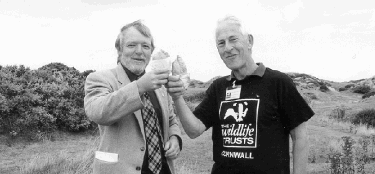People like you are the key to the
Trust's continuing and growing success. Here are just a few examples of
the ways in which members have helped us - or can help us - to achieve
our shared aims.
A MESSAGE FROM OUR CHAIRMAN
Cornwall Wildlife Trust - quo
vadis?
This question has recently been exercising
the minds of the Trustees: where is the Trust heading in the future?
As the Trust approaches its 40th year,
the basic reason for founding this organisation has not changed - to protect
our native flora and fauna (from the predations of Homo sapiens).
What is changing, however, is the emphasis we place upon the role of Homo
sapiens within the wider picture of nature conservation.
In the past, the general approach might
have been summed up as protecting wildlife by keeping selected "nature
reserves" at a distance from (most) people and their activities. At its
last meeting, the Council (the Trustees of the Cornwall Wildlife Trust)
voted unanimously to embrace a broader concept. Under the umbrella of
"education for life", it is now accepted that if our wildlife is to have
any chance of survival then the whole of mankind must be educated to be
involved in its protection.

In future we shall be looking closely
at further activities in which the general public would be invited to
participate. For example, we could become partners in something like
a "country park and interpretation centre". This would involve people
from all walks of life - children and pensioners, tourists and locals,
athletes and handicapped - in learning about, and so gaining a greater
degree of enjoyment and understanding from, the wildlife all around
us.
Just a word of reassurance: any proposed
new
activity in this realm will be closely
examined to ensure that it fulfils two criteria - first that there is
a genuine involvement in protecting the flora and fauna of Cornwall,
and secondly that we can draw down adequate funding to pay for these
new activities.
Watch this space!
Howard Curnow
HEDGE SHARES
Starting in Oldenburg on 7th June
2001, a group of a dozen members of NABU Lower Saxony, the Trust's twinning
partner, will cycle to Land's End in a thousand-mile bike trip, arriving
there on 1st July. The aim of this enthusiastic venture is to raise
public awareness of the value of hedgerows as "green links" and "corridors
for life" in our landscape and to collect donations to enable both the
Trust and NABU to protect existing hedges or to plant new ones. As a
special "thank you", the organisations have created five symbolic "hedgerow
shares" of different "value". For a donation of £2 the supporter
will get a "wren share", for £3.50 a "yellowhammer share", for
£7 a "robin share", for £18 a "song thrush share" and finally
for £35 a "hedgehog share". All these "shares" are painted in black
and white by one of the most famous nature painters in Europe, Claus
Rabba from Varel, who did this free of charge! These "shares" (with
an English text) are available at Trust HQ and they make attractive
presents for friends - everybody should support this campaign and contribute
to our blooming hedgerows. So please don't hesitate to order your shares
- the animals and flowers of the hedgerows will say "thank you" perhaps
for hundreds or thousands of years.
Rudiger Wohlers

The Trust's membership has
now topped 7,500. Our 7,500th member, Mary Williams of Landrake, and her
son Jack received a special presentation from Business and Resources Manager
Alison Vaughan (right) at Tincombe Nature Reserve in Saltash in October.
As well as marking a major milestone for the Trust, the event was arranged
to highlight the crucial importance of our members.
Photo: Gavin Henderson
Bert Biscoe (left), Cornwall
County Council's Executive Member for the Environment, enjoys a pasty
with Trust Chairman Howard Curnow at the official hand-over of Upton Towans,
near Hayle, in August. This new Trust reserve, which will be managed jointly
with the Hayle-Gwithian Countryside Service, receives many more visitors
than most of our holdings and offers great potential for public involvement.
Photo: Stuart Hutchings
Wild Cornwall - Issue No.84 - Spring 2001